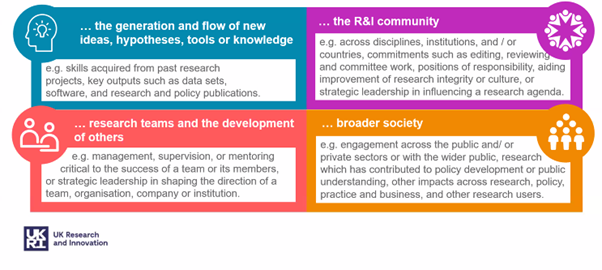
Narrative CVs also known as the Resume for Research and Innovation (R4RI)
The promotion of the narrative CV as part of funding applications has come about due to efforts by a range of funders to address issues of equity in research funding and to improve research culture. The narrative CV is a move away from the listing of journal-based metrics and funding awards to evaluating the researcher and research teams in terms of their contributions to knowledge generation, teams and engagement. The Health and Care Research Wales Faculty has embraced the Narrative CV for all of its personal award competitions.
What is a narrative CV?
Different funders suggest different formats and methods for telling your research story but central to all of them is the move towards written descriptions, skills, experiences, contributions and impact. The days of updating your CV by adding you latest publications and grants to the bottom of the list on the old version are over. Your chosen funder will provide instructions about the format they require, look at it carefully. They will essentially be asking you to describe yourself as a researcher in response to four different (domains – see the UKRI’s Resume for Research and Innovation template image below, each section is a domain). Your task is to identify activities, events, stories and examples from your research career that relate to these domains. But you are usually limited to about 1000 words to cover all sections, which means you need to choose what aspects you focus on wisely.

Credit: UKRI’s Resume for Research and Innovation template
How do I develop my narrative CV?
Stepping away from bullet points to using a more personal voice is key. You would be forgiven for thinking that writing in full sentences wouldn’t be so hard for researchers whose currency is journal articles and funding applications (and we all know how long and repetitive they can be) but creating a narrative CV can be daunting.
When you identified what you want to say in relation to the four domains you need to decide which one provides the best chance for you to describe the contribution you have made as a researcher and that you would want the reviewers to know about. I like to think about the domains as buckets*.
Given the word limits you can really only justify putting each contribution in one bucket. The more bespoke options you have to fill those buckets the better so think about keeping a narrative CV journal that captures everything you do as a researcher. Getting into the habit of keeping a journal of all your activities will help you to see the domains which you may need to put a bit more effort into. Remember you will need to rewrite your narrative CV for every application you make and you don’t want to be searching back through your calendar and emails for examples and testimonials: Think about your narrative CV, do you have any gaps you can close before you write it: could you offer to give a talk? Write a blog? Act as a mentor? Organise an event?
When choosing your examples you need to think very strategically:
- Will the panel be able to see and understand me as a researcher from this example?
- How does it fit this specific application I am making?
- Do the reviewers need to know this about me?
If the answer to any of these questions is “No” or “I’m not sure” then it doesn’t go in the bucket.
As with all writing tasks the key is to draft, draft and redraft. This is not going to be a quick process or something you should leave until the last minute. Each contribution you select for one of your buckets needs to do a lot of heavy lifting. There are no free passes even for publications and grants but of course you can link to your ORCID ID to make sure they do know about all of these. Everything that is described in your narrative CV must earn its place by virtue of demonstrating to the panel that you are the right person, in the right place, with the right project plan to carry out the work you are proposing, if it doesn’t demonstrate this, then it doesn’t go in. You have only 1000 words to persuade them so you need to succinctly capture your track record, skills, network, reputation and impact. After your first draft, put it aside for a day or two before you edit and redraft. Good narrative CVs need time to mature.
Final thoughts
The narrative CV is a welcome departure from the old metrics based chronological CV that privileges researchers who are full-time and who have had a more linear career.
How many times have you received feedback from a funding panel and felt: if you could have just been in the room to tell them about your passion, your unique insight and your drive to change things for the better then the outcome would have been different?
Well, here’s your chance, give them the story behind the metrics and the h-index.
*There is an “overflow bucket” for other information about you and your research trajectory but this is not to be used to circumvent the word limits